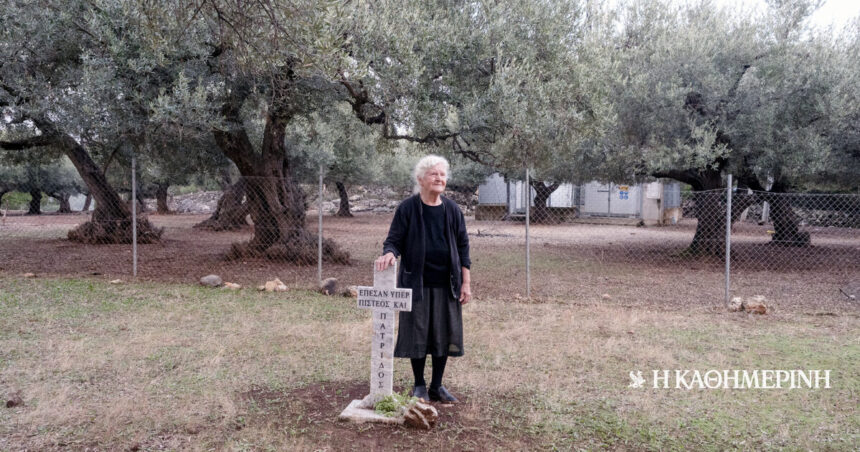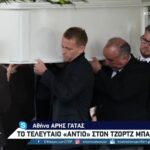OR Katerina Koraki he made the first search attempt years ago, with the help of an Albanian worker he had met in Sifnos. He volunteered to show her the places where her father, one of his thousands of fallen, was probably roughly buried Greco-Italian War. They were walking blindly, not knowing whether they would find a tomb or some other sign on the earth. The effort then did not pay off. Other visits to the area followed, while a relative of the family has provided a DNA sample hoping for an identification if the dead soldier’s bones are ever found. His daughter is now 83 years old, she didn’t get to know him.
“When my grandfather left the island for the front, my grandmother was pregnant. My mother never saw him, she was deprived of his embrace since her birth,” Maria Koraki, granddaughter of the fallen, tells “K”. “All these years later, she feels the same emptiness, she carries within her a pendingness like a thorn. It is driven to find him».
The peson was called Michalis Nikiforakis. He was injured at the beginning of the war and was transferred with frostbite to the Second Pelvic Surgery, which had been established in the village of Kosina, near Premeti. There he expired. He was allegedly then buried casually, in the precincts of a church, together with other Greek soldiers.
The decades pass and the identification of the fallen of the Greco-Italian War remains an unfulfilled debt for the Greek state. The bilateral agreement between Greece and Albania was signed in 2009, but it took another nine years to start work on the field in the Dragot area. The total number of casualties reached 8,002, of which 7,976 belonged to the Army and 26 to the Air Force. Excavations are currently being carried out in the area of Premeti, near a stadium, in collaboration with the corresponding Albanian group of experts.
“The army of thousands of dead Greeks is still buried in all the toponyms of the northern mainland Hellenism. Both the Hoxha and Alia regimes, and then successive governments in Tirana, by their behavior seemed to think that the dead Italians who fell in 1940-41 should be treated better than the Greeks, who fell fighting against forces of Fascist Italy”, notes Alexandros Mallias, who had been the ambassador of Greece in Albania. He points out that the bureaucratic obstacles and delays seem to be a thing of the past and that for the last six years the implementation of the bilateral agreement has been progressing without a hitch.
For years, hundreds of relatives of the fallen have given DNA samples in the hope that after the exhumations the first identifications could be achieved. According to the data provided to “K” by the Greek group of experts of the General Staff of National Defense, no result has been achieved so far. The passage of decades and the effect of weathering on the remains results in only 17% of the bones yielding usable DNA and a corresponding percentage being partially usable. 66% is unexploitable.
According to the Greek group of experts, the process of procuring equipment that implements a new DNA analysis method is underway. Investigations based on this method are expected to begin in 2025 and the authorities estimate that the usable percentage of the samples will rise from 17% to 80% to even 90%.
“Successive governments of Tirana with their behavior as if they considered that the dead Italians who fell in 1940-41 should be treated better than the Greeks…”.
In her yard
For the last year and a half, the photographer Thodoris Nikolaou has been visiting the Albanian border trying to map the places where the battles of the Greco-Italian War took place. On one of these trips he also found himself at the home of Hermione Brigou, on a hill at the foot of Mount Scutari, in Heimarra. The old woman was willing to talk for hours and recount what she experienced during the war years. In 1941, six Greek infantrymen were buried in her yard, who were killed in a battle that had taken place near the family’s house. Brygu was then 9 years old. From that moment he shouldered the duty of guarding the monuments. “Those ugly mothers. They did not cry over them, nor were they to be read in church, nor were they to wear their good clothes, nor were they to be embraced by anyone“, he told the photographer.
Last year, during one of these trips during the celebration of October 28, Nikolaou photographed a woman in the cemetery of Kleisoura. Stamatia Kyriakaki stood mute, with a frame in her lap. She was holding the black-and-white photo of her father, late Charalambos Kyriakakis, who was killed on March 17, 1941, on Dodi Hill, near Lekli. He was born in 1912 in Agia Marina, Chania.


In Albania, two cemeteries have been built for the burial of the Greek dead, one in Vouliarates and the other in Kleisoura. A total of 1,003 Greek soldiers have been buried in them with honors, in a total of six ceremonies.
Back in Greece, Nikolaou also visited Brigadier General E.A. Konstantinos Rodopoulos and photographed part of his archive. Rodopoulos was one of the pioneers of the initially informal investigations of locating and exhuming the bones of the fallen of the Albanian front. “Personally, it hurt me that they were there unburied, that no one gave them a trisago. They were inside me, I felt them as my fellow soldiers. I felt heavy the legacy to look for them and by good luck to be the one who, together with other colleagues, would do the trisago”, he had previously stated in “K”. The testimonies of the local population proved to be pivotal in that endeavour.
In his rich archive there is, among other things, a report from December 1998 about an exhumation near a house in a village near Premeti, where decomposed bones were found inside a rotten wooden box. “The skull face down, with a large hole in the right forehead,” noted the supervisor of that excavation. That year, 475 burials were exhumed in the wider area of Dropoli (Vouliarates, Kleisoura).

In the little church
Maria Koraki traveled with her mother to Albania in 2017. They had already been in contact with economist Agathoklis Panagoulias, who has devoted decades of private research to documenting the casualties of the Albanian front. The evidence he had managed to collect indicated that Michalis Nikiforakis was probably buried there, in the courtyard of the church in Kosina.
“I felt awe,” says Maria Koraki, recalling that visit. “I thought about where he had started, young, how much he went through and what struggle he gave, what he pulled to the front without proper supplies and clothing, suffering from frostbite.”
Now, he is waiting for the investigations to proceed further in the area of Premeti and for corresponding actions to follow in Kosina. “We hope he is identified and put to rest. It will be a relief to know that it has been properly buried“, she says of her grandfather. She has long since made a promise to her elderly mother that she will continue her work, no matter how long it takes. The search will not stop.




